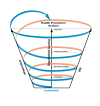ParticipACTION: Baseline assessment of the capacity available to the 'New ParticipACTION': A qualitative study of Canadian organizations
- PMID: 19995458
- PMCID: PMC2796988
- DOI: 10.1186/1479-5868-6-87
ParticipACTION: Baseline assessment of the capacity available to the 'New ParticipACTION': A qualitative study of Canadian organizations
Abstract
Background: Evaluation of the original ParticipACTION campaign effects focused on individual awareness, recall, and understanding. Less studied has been the impact such campaigns have had on the broader organizational capacity to mobilize and advocate for physical activity. With the relaunch of ParticipACTION, the purpose of this study was to qualitatively explore baseline organizational capacity to promote physical activity messages, programs, and services within the Canadian context.
Methods: Using a purposeful sampling strategy, we conducted semi-structured telephone interviews with 49 key informants representing a range of national, provincial, and local organizations with a mandate to promote physical activity. Interview data were analysed using a thematic analytic approach.
Results: Key informants painted a generally positive picture of current organizational capacity to promote physical activity messages, programs, and services in Canada. Will and leadership were clear strengths while infrastructure limitations remained the greatest concern. Some specific challenges included: 1) funding issues: the absence of core funding in a climate of shifting funding priorities; 2) the difficulty of working without a national physical activity policy (lack of leadership); 3) inconsistent provincial and educational sector level policies; and 4) a persistent focus on obesity rather than physical inactivity.
Conclusion: The data generated here can be utilized to monitor the future impact of ParticipACTION on enhancing and utilizing this organizational capacity. A range of indicators are suggested that could be used to illustrate ParticipACTION's impact on the broad field of physical activity promotion in the future.
Figures
Similar articles
-
Perceptions of organizational capacity to promote physical activity in Canada and ParticipACTION's influence five years after its relaunch: a qualitative study.Health Promot Chronic Dis Prev Can. 2018 Apr;38(4):170-178. doi: 10.24095/hpcdp.38.4.03. Health Promot Chronic Dis Prev Can. 2018. PMID: 29671966 Free PMC article.
-
Exploring the impact of the 'new' ParticipACTION: overview and introduction of the special issue.Health Promot Chronic Dis Prev Can. 2018 Apr;38(4):153-161. doi: 10.24095/hpcdp.38.4.01. Health Promot Chronic Dis Prev Can. 2018. PMID: 29671964 Free PMC article. Review.
-
ParticipACTION: Baseline assessment of the 'new ParticipACTION': A quantitative survey of Canadian organizational awareness and capacity.Int J Behav Nutr Phys Act. 2009 Dec 9;6:86. doi: 10.1186/1479-5868-6-86. Int J Behav Nutr Phys Act. 2009. PMID: 19995457 Free PMC article.
-
ParticipACTION after 5 years of relaunch: a quantitative survey of Canadian organizational awareness and capacity regarding physical activity initiatives.Health Promot Chronic Dis Prev Can. 2018 Apr;38(4):162-169. doi: 10.24095/hpcdp.38.4.02. Health Promot Chronic Dis Prev Can. 2018. PMID: 29671965 Free PMC article.
-
Evidence Brief: The Effectiveness Of Mandatory Computer-Based Trainings On Government Ethics, Workplace Harassment, Or Privacy And Information Security-Related Topics [Internet].Washington (DC): Department of Veterans Affairs (US); 2014 May. Washington (DC): Department of Veterans Affairs (US); 2014 May. PMID: 27606391 Free Books & Documents. Review.
Cited by
-
Systematic review of the barriers and facilitators to cross-sector partnerships in promoting physical activity.Perspect Public Health. 2024 Nov;144(6):369-380. doi: 10.1177/17579139231170784. Epub 2023 Jun 18. Perspect Public Health. 2024. PMID: 37332258 Free PMC article.
-
Perceptions of organizational capacity to promote physical activity in Canada and ParticipACTION's influence five years after its relaunch: a qualitative study.Health Promot Chronic Dis Prev Can. 2018 Apr;38(4):170-178. doi: 10.24095/hpcdp.38.4.03. Health Promot Chronic Dis Prev Can. 2018. PMID: 29671966 Free PMC article.
-
Exploring the impact of the 'new' ParticipACTION: overview and introduction of the special issue.Health Promot Chronic Dis Prev Can. 2018 Apr;38(4):153-161. doi: 10.24095/hpcdp.38.4.01. Health Promot Chronic Dis Prev Can. 2018. PMID: 29671964 Free PMC article. Review.
-
ParticipACTION: the future challenges for physical activity promotion in Canada.Int J Behav Nutr Phys Act. 2009 Dec 9;6:89. doi: 10.1186/1479-5868-6-89. Int J Behav Nutr Phys Act. 2009. PMID: 19995460 Free PMC article.
-
Evaluating the uptake of Canada's new physical activity and sedentary behavior guidelines on service organizations' websites.Transl Behav Med. 2013 Jun;3(2):172-9. doi: 10.1007/s13142-012-0190-z. Transl Behav Med. 2013. PMID: 24073168 Free PMC article.
References
-
- Bauman A, Smith BJ, Maibach EW, REger-Nash B. Evaluation of mass media campaigns for physical activity. Eval Program Plann. 2006;29:312–322. doi: 10.1016/j.evalprogplan.2005.12.004. - DOI
-
- McGrath J. In: Designing Health Messages. Maibach E, Parrott RL, editor. Thousand Oaks, CA: Sage; 1995. The gatekeeping process: The right combination to unlock the gates; pp. 199–216.
-
- Lagarde F. The mouse under the microscope. Keys to ParticipACTION's success. Can J Public Health. 2004;95(Suppl 2):S20–24. - PubMed
Grants and funding
LinkOut - more resources
Full Text Sources


